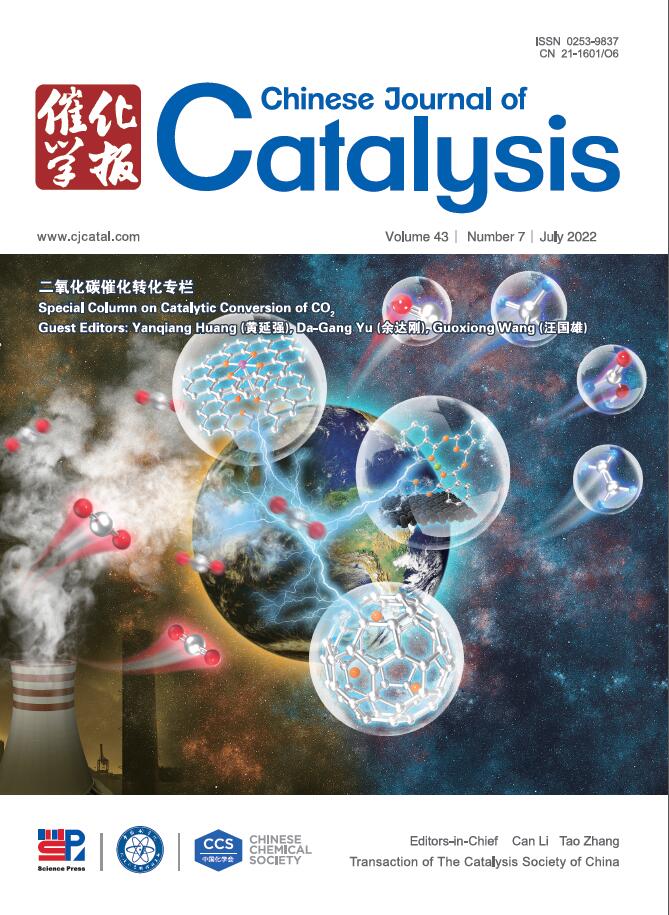沸石包裹的单铬位点催化的二氧化碳促进的乙苯脱氢反应
IF 15.7
1区 化学
Q1 CHEMISTRY, APPLIED
引用次数: 0
摘要
碳氢键的选择性活化是催化碳氢化合物转化为增值化学品的关键。乙苯脱氢制苯乙烯是生产聚苯乙烯及其衍生物用于合成材料的关键工艺。本文构建了以沸石包裹的O=Cr(VI)=O为分离物,经框架外钾离子修饰的K-Cr@Y催化剂,在co2促进的乙苯脱氢反应中表现出优异的性能,初始乙苯转化率为66%,苯乙烯选择性为96%,优于其他M-Cr@Y催化剂(M = Li, Na, Rb, Cs)。框架外钾离子可以调节沸石包裹Cr(VI)的电子密度,从而促进乙苯分子中C-H键的激活。综合表征结果表明,在乙苯脱氢过程中,沸石包覆的O=Cr(VI)=O被二氢逐渐还原为活性较低的Cr(IV)=O,且Cr(IV)=O经简单焙烧再生后可再氧化为O=Cr(VI)=O。原位漂移光谱的结果阐明了CO2在K-Cr@Y上乙苯脱氢过程中的关键促进作用,通过延缓沸石包裹的Cr种过度还原为活性Cr(III)种和抑制焦炭沉积。本研究提出了框架外阳离子调控沸石包裹的高价过渡金属离子催化乙苯脱氢的非贵金属催化剂的合理设计。本文章由计算机程序翻译,如有差异,请以英文原文为准。
CO2-promoted ethylbenzene dehydrogenation catalyzed by zeolite-encaged single chromium sites
The selective activation of C-H bonds is pivotal in catalysis for converting hydrocarbons into value-added chemicals. Ethylbenzene dehydrogenation to styrene is crucial process to produce polystyrene and its derivatives used in synthetic materials. Herein, K-Cr@Y with zeolite-encaged isolated O=Cr(VI)=O species modified by extraframework potassium ions is constructed, showing remarkable performance in CO2-promoted ethylbenzene dehydrogenation with initial ethylbenzene conversion of 66% and styrene selectivity of 96%, outperforming other M-Cr@Y catalysts (M = Li, Na, Rb, Cs). Extraframework potassium ions can modulate the electron density of zeolite-encaged Cr(VI) species and therefore facilitate C–H bond activation in ethylbenzene molecules. The gradual reduction of zeolite-encaged O=Cr(VI)=O to less active Cr(IV)=O species by dihydrogen during ethylbenzene dehydrogenation is evidenced by comprehensive characterization results, and Cr(IV)=O can be re-oxidized to O=Cr(VI)=O species upon simple calcination regeneration. The results from in situ DRIFT spectroscopy elucidate the critical promotion role of CO2 in ethylbenzene dehydrogenation over K-Cr@Y by retarding the over-reduction of zeolite-encaged Cr species to inactive Cr(III) species and suppressing coke deposition. This study advances the rational design of non-noble metal catalysts for CO2-promoted ethylbenzene dehydrogenation with zeolite-encaged high valence transition metal ions modulated by extraframework cations.
求助全文
通过发布文献求助,成功后即可免费获取论文全文。
去求助
来源期刊

Chinese Journal of Catalysis
工程技术-工程:化工
CiteScore
25.80
自引率
10.30%
发文量
235
审稿时长
1.2 months
期刊介绍:
The journal covers a broad scope, encompassing new trends in catalysis for applications in energy production, environmental protection, and the preparation of materials, petroleum chemicals, and fine chemicals. It explores the scientific foundation for preparing and activating catalysts of commercial interest, emphasizing representative models.The focus includes spectroscopic methods for structural characterization, especially in situ techniques, as well as new theoretical methods with practical impact in catalysis and catalytic reactions.The journal delves into the relationship between homogeneous and heterogeneous catalysis and includes theoretical studies on the structure and reactivity of catalysts.Additionally, contributions on photocatalysis, biocatalysis, surface science, and catalysis-related chemical kinetics are welcomed.
 求助内容:
求助内容: 应助结果提醒方式:
应助结果提醒方式:


